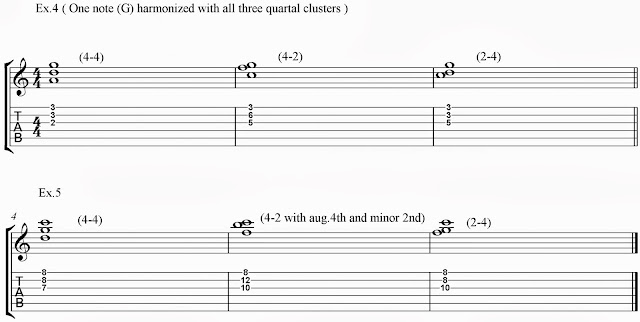Major Diatonic Series of 7th Chords:
I Cmaj7 No Perfect 11th (4th scale degree)
ii Dmin7
iii Emin7 No Minor 9th (2nd degree) or Minor 13th (6th degree)
IV Fmaj7
V G7 No Perfect 11th (4th degree)
vi Amin7 No Minor 13th (6th scale degree)
vii Bmin7(b5) No Minor 9th (2nd degree) or Minor 13th (6th degree)
Now, let's take a look at Figure 1 below, which shows the G Mixolydian mode (C major scale starting on 5th degree) and the outlined chord tones for it's chord, G7. Notice how the chord tones outlined for G7 are every other scale tone (intervals of 3rds) in the series.
In Figure 2, we have the same G mixolydian mode extended up two octaves. Notice again how the chord tones are every other scale tone in intervals of 3rds. If we keep going up past the octave in 3rds, we get all of the extensions of the chord. Notice how I have the 11th crossed out in Figure 2. If you look at the list of "avoid notes" at the top of the page, you will see that the 11th is an avoid note for the V chord. In this case, the note C is the perfect 11th and is omitted from G7.
Figure 3 demonstrates the entire series of chord tones and agreeable extensions in the scale played in harmony to create the chord G9(13). The reason why the "13" is in parentheses is because the perfect 11th is not an agreeable extension and is omitted. Writing G13 would tell us that we have all 3 extensions, unaltered, in the chord but since there is no 11th included, we write G9 and put the 13 in parentheses...it's a clear way of communicating chord nomenclature.
Substituting Primary Chord Tones With Extensions In 4-Note Voicings
Note: As in PART 1, since these voicings will not contain the root, it is important to hear it elsewhere. Use a looping or recording device and record a low "G" root note to play your G9 and G9(13) voicings over.
These chords are most effective and less ambiguous when played with a bassist or other instrument covering the lower part of the collective harmony which is usually playing the roots of the chords.
In 7th chord harmony, it is not always necessary to include the 5th of the chord. Altered 5ths such as diminished or augmented 5ths are more important because they highlight a specific sound. If you play a G7 chord and take out the perfect 5th, it will still sound like a G7. A G7(#5), on the other hand, will lose a great deal of it's character if the augmented 5th is removed because of the color and tension that the altered 5th gives it. Something to think about as far as your options go on guitar.
Let's get to work!
We are going to put this stuff to work just like we did in PART 1 starting with a basic 4-note chord voicing for G7 in Ex.1 below. To the right of G7, shows the use of a tone substitution by moving the root note, G, up a whole step to A, while the others remain in place. The note A is the second note of the the G Mixolydian mode and functions as the Major 9th of the chord. This makes G7 become G9 in what we call the 9-for-1 substitution talked about in PART 1.
Check out Ex.2 below. Just like in Ex.1, we are going to use the 9-for-1 substitution only we are going to also add what's called a 13-for-5 substitution which is taking the 5th (D) and moving it up a whole step to E to make it the Major 13th. G7 on the left becomes G9(13)
After you get the hang of this, try the same thing with some of the other chords listed at the beginning of this chapter. You can find some really cool voicings and come up with your own chord progressions while employing them. Also, try different inversions of the chord you are working with. For example, G7, in Ex.3 below, could be voiced like so before applying the 9-for-1 and the 13-for-5 substitutions.
In the end, it's all about what sounds good to you. If you want to play "avoid notes" in your voicings, nothing is stopping you. It's all about what sounds good to you...which is the most important thing. I will cover more on this subject later on. If you aren't up to speed on chord/scale relationships, chord functions, and harmonic tension and resolution, I would recommend diving deeper into it. It's tons of fun and a great way to broaden your process for figuring out musical problems or generating new and interesting sounds.
































